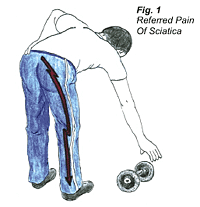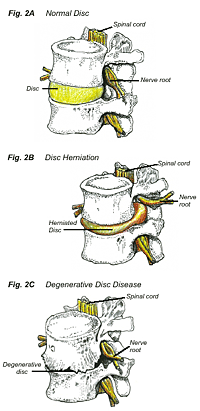 Sciatica is a condition in which the pain is typically perceived as radiating from the low back to the posterior buttocks, posterior thigh, and occasionally below the knee into the posterior calf and foot (Fig. 1). A disc herniation (Fig. 2B) or degenerative changes in the lumbar spine (Fig. 2C) can lead to sciatica. A normal, unherniated disc, in comparison, is shown in Figure 2A.
Sciatica is a condition in which the pain is typically perceived as radiating from the low back to the posterior buttocks, posterior thigh, and occasionally below the knee into the posterior calf and foot (Fig. 1). A disc herniation (Fig. 2B) or degenerative changes in the lumbar spine (Fig. 2C) can lead to sciatica. A normal, unherniated disc, in comparison, is shown in Figure 2A.
Sciatica may be caused by direct pressure on the lumbar nerve roots. Each nerve root has a sensory and motor component to it, supplying a particular part of the body. The sensory part carries sensory signals to the brain and the motor part carries signals that activate the muscles. In this case, the lumbar nerve roots supply the lower extremities, so excess pressure on the lumbar nerve roots causes discomfort and/or pain in the buttocks and legs.
The sciatic nerve is the largest nerve in the body and is formed by the conjoining of the fourth lumbar, fifth lumbar, first sacral, second sacral, and third sacral nerve roots (Fig. 3A and 3B). The sciatic nerve travels from the front of the pelvis to the buttock region through an opening called the greater sciatic foramen. From there, it continues to the hamstring musculature in the posterior thigh, traveling below the knee where it divides into two nerves, the tibial nerve and peroneal nerve.
Sciatica Due to Herniated Disc
 A disc herniation is a “leaking” of a portion of the jelly-like material between two vertebrae, and occurs most frequently in the third to fifth decades of life. The disc, the shock-absorbing cushioning between vertebrae, may become prone to tears because of weakening of the fibers that surround the nucleus pulposis, which is the center of the disc (Fig. 4A and 4B).
A disc herniation is a “leaking” of a portion of the jelly-like material between two vertebrae, and occurs most frequently in the third to fifth decades of life. The disc, the shock-absorbing cushioning between vertebrae, may become prone to tears because of weakening of the fibers that surround the nucleus pulposis, which is the center of the disc (Fig. 4A and 4B).
Repetitive flexion (such as bending over frequently), especially when combined with rotation (such as swinging an ax) or a high force trauma (such as a car accident) can cause radial tears in the disc. These radial tears will allow the leakage of the nucleus pulposis to herniate into the spinal canal, which can cause compression on a lumbar nerve root, resulting in sciatica. In this situation, the sufferer will complain of pain when sitting or standing with a forward flexed posture, which causes further migration of the jelly-like material into the spinal canal. Conversely, when bending backwards, pain may subside because the nucleus pulposis will travel back towards the away from the nerve root, taking pressure off the nerve root.
Sciatica Due to Degenerative Changes in the Spine
The most common cause of sciatica in people over the age of 50 is degenerative changes in the lumbar spine. These degenerative changes can lead to narrowing of the spinal canal and the intervertebral foraminal space (the space between two adjacent vertebrae), Conservative where the lumbar nerve roots exit the and become part of the sciatic nerve. This narrowing can cause direct pressure on the lumbar nerve roots, leading to radiating pain in the buttocks and back of the thigh and leg.
 These symptoms may become less intense when bending forward, which opens up the intervertebral foraminal space and takes pressure off the nerve root. Bending backwards, on the other hand, will narrow the intervertebral foraminal space, increasing pressure on the exiting nerve root, causing increased pain. Note that this is in direct contrast to suffering from sciatica due to a herniated disc: patients’ descriptions of that cause pain and that bring relief are used to help determine the cause of the sciatica.
These symptoms may become less intense when bending forward, which opens up the intervertebral foraminal space and takes pressure off the nerve root. Bending backwards, on the other hand, will narrow the intervertebral foraminal space, increasing pressure on the exiting nerve root, causing increased pain. Note that this is in direct contrast to suffering from sciatica due to a herniated disc: patients’ descriptions of that cause pain and that bring relief are used to help determine the cause of the sciatica.
A patient reporting pain or tingling down both lower extremities as well as a recent history of a loss of bladder or bowel control would immediately be referred to a neurosurgeon or orthopaedic surgeon to rule out the possibility of cauda equina syndrome. If diagnosed with this condition, the affected disc would be removed as soon as possible in attempt to prevent irreversible paralysis.
Sciatica-Like Symptoms Caused by Muscle Strain
Repetitive strain injury of the piriformis musculature and gluteus maximus musculature can cause pain in the buttocks and hamstring region (Fig. 3A). This pain does not typically radiate below the knee, unlike true sciatica, which can reach to the calf. Driving for long periods with the foot on the accelerator and/or sitting with a heavy wallet in the back pocket can directly irritate the gluteus maximus and piriformis musculature. Taking breaks when driving and removing the wallet from the back pocket would help to alleviate strain on these muscles. Using a cold pack (20 minutes on / 1 hour off) would help to decrease inflammation of this area.
Sciatica-like Symptoms Caused by Athletic Injury

Running can cause stress on the gluteus maximus and piriformis musculature. With each heel strike, there is a normal internal rotation of the femur, whose motion is controlled by the piriformis musculature; overtraining may cause injury to the piriformis. Running uphill will cause forward flexion of the pelvis, which in turn may cause a strain of the gluteus maximus musculature (which normally posteriorly rotates the pelvis).
Running injuries leading to sciatica like symptoms can be avoided by changing sneakers every 250-400 miles, at which point the sneaker loses 40% of its shock absorption capabilities. Initiating a good flexibility and strength program for the lower extremities would help in the prevention of repetitive strain injuries such as sciatica.
Biking with the pelvis flexed too far forward while reaching for the handlebars can also strain the gluteus maximus musculature. If the handlebars are set too far below the seat level, the rider may be forced to lean too far forward. A proper bike fitting may help prevent this injury. Be sure to consider bike size, seat height, and handle-bar height/angle.

Conservative therapy of sciatica at Dr. Dubin’s office would consist of:
- Deep tissue therapy to the muscles in the low back and buttock regions to free up soft tissue motion
- Adjustments of the facet joints (joints between two vertebrae) in the lumbar spine to free up joint motion
- Ultrasound / electric muscle stimulation to relax the musculature and restore normal muscle tone
- Recommendation and demonstration of a home strengthening and flexibility routine for the lower extremities
- Recommendation to reduce body weight, if necessary, via exercise routine and referral to a registered dietitian for a nutrition consultation.
If conservative therapy fails, a referral to an orthopaedic or neurosurgeon for an evaluation would be recommended.
Recommendations following an initial evaluation may include the following two procedures:
- For a herniated disc: A partial discectomy, a surgical procedure to remove the portion of the posteriorly herniated disc causing compression on a lumbar nerve root.
- For sciatica caused by degenerative changes in the lumbar spine: A laminectomy to widen the spinal canal and removal of unnecessary ligament material and bone spurs that are irritating the nerve root in the central canal and intervertebral foraminal space

